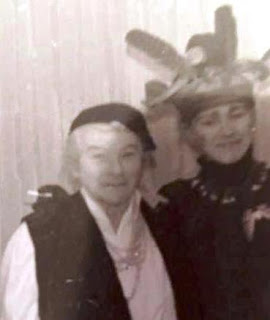Jeremy Cameron is an author whose grandmother and aunts ran Elizabeth's the Wool Shop on Wilbraham Road and recently he agreed to provide an account of their shop.
 |
| 510 Wilbraham Road, 1959 |
My grandmother, Frances Hannah Marsh, was born in 1872.
At this distance her early history is a bit vague but as far as I know she was born in Belfast, emigrated with her family as a child to Canada where she crossed the country in a covered wagon and then returned.
She married Jack Cameron, whose first wife had died and who already had one child, Fred.
My grandmother had a number of children of whom six survived into adulthood: Jim (originally called Duncan), Frances, Albert, Hilda, Ethel and Leslie (my father) who was born when she was 43.
The family grew up in Barrow in Furness, where Jack Cameron worked in the shipyards. He died around 1923 and subsequently my grandmother moved to Buxton, Derbyshire, where she kept the fish and chip shop on the market place.
At some time during or more probably just after the Second World War she moved with her daughters Hilda and Ethel to 510 Wilbraham Rd, Chorlton-cum-Hardy, where she kept Elizabeth, the wool shop. She died on 6th Feb 1958, the same day as the Munich air crash.
My grandmother was a much loved but stern lady. She was alleged to maintain the posture of her children at the meal table by putting a walking stick down their backs. Curious about the workings of the shop, I asked her one day how much money she had taken that day. "One pound thirty-five and fourpence," was her reply. It was her standard reply and it took me a while to work out that it meant nothing. You didn't mess with her. The family clubbed together to buy her a television in old age and we all watched the Coronation in 1953.
Incidentally the shop is more or less equidistant between Old Trafford and Maine Rd (the Etihad is of course much further). My father took me to my first match at Maine Rd in 1954 (City 2 Arsenal 2) and later I would walk to Old Trafford.
My aunts kept the shop for another few decades until their very late retirement when they went into a care home across the street. Their shop was, I believe, legendary. People have told me that they would travel up to fifty miles to buy wool from my aunts or to ask their advice about knitting, needlework or embroidery.
The shop would sell a button or an inch of cotton or anything else that was needed. Every evening they would knit in front of the television. What were they knitting? Garments for their customers. What did they charge? Nothing! They charged for the wool but their services came free.
Life became hard as supermarkets and department stores began selling their products and specialist shops grew scarce. Fortunately they had the opportunity to buy their property early on for a very low price, otherwise they would have struggled much more. Until they got their old age pensions money was at a premium; after that, they could manage.
 |
| 510 Wilbraham Road, 2016 |
Of all the people I have met who knew my aunts I doubt whether anyone called them by their first names.
"Good morning, Miss Cameron," said the customers in the shop or their neighbours such as the excellent Chorlton bookshop or Mr Clayton next door.
"Elizabeth, Miss Cameron speaking," they said on answering the 'phone.
They disapproved of quite a few things, most notably bad manners, and did not hang back from correcting children who disrespected their parents in the shop; on the other hand they were quite likely to give the same child a small present on leaving.
Their politics were eccentric and best not examined too closely. Despite the fact that they got on well with people of all races and creeds their major fear was that on retirement their shop would go to "a Chinese take-over". Which, I believe, happened.
Since they died that part of the family has lost all contact with each other. They and their shop were the fulcrum.
I understand that on their retirement the shop fittings - glass cases for wool, intricate drawers for cottons - were bought by television for period programmes. I can imagine people today watching a Dickensian series and suddenly crying out: "Oh! I knew a shop just like that! Elizabeth! Miss Cameron and Miss Cameron!"
Location; Chorlton, Manchester
Text © Jeremy Cameron, 2016,
http://www.jeremycameron.co.uk/books/
Picture,
Wilbraham Road north side, Shops 510-512, A E Landers, May 24 1959, m18272, courtesy of Manchester Libraries, Information and Archives, Manchester City Council, http://images.manchester.gov.uk/index.php?session=pass and 510,January 2016 courtesy of Tiny's Tipple,
http://www.tinystipple.co.uk/

















































